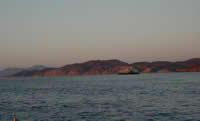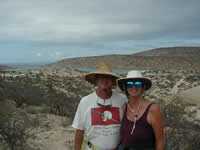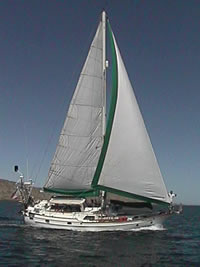| Volume
83
September 4-18
Making our way to BLA
It was still pitch dark when we woke at five am
intending to make an early getaway from Marina Santa Rosalia. With
the year waning and our longitude very close to the western edge
of the time zone, dawn was much farther off than we imagined. We
also hadn't realized that the town turns off the bright waterfront
lights sometime after midnight! So instead of pushing things we
sat in our ready boat and sipped coffee until the horizon began
to lighten. When we finally slipped quietly out from between our
sleeping neighbors and stole away north, we were amazed to discover
it was nearly seven o'clock!
 Our
plan was to make for Punta Trinidad, billed as a good summertime
anchorage, a bit more than halfway to Bahia San Francisquito. After
weeks in civilization the two captains were itching for a one-boat
anchorage and a chance to swim. The morning started ideally, with
a beautiful sunrise on Cabo Tres Virgenes and our first Mexican
dorado on the line (well our first on the line that made it into
the boat!) midmorning. We had mahi sashimi for lunch, and life was
looking good! Our
plan was to make for Punta Trinidad, billed as a good summertime
anchorage, a bit more than halfway to Bahia San Francisquito. After
weeks in civilization the two captains were itching for a one-boat
anchorage and a chance to swim. The morning started ideally, with
a beautiful sunrise on Cabo Tres Virgenes and our first Mexican
dorado on the line (well our first on the line that made it into
the boat!) midmorning. We had mahi sashimi for lunch, and life was
looking good!
But Punta Trinidad was a disappointment. It was
shallower and less protected than anticipated, and when we dropped
the sails and rounded in, old Tacky II was rolling heavily. Quite
disappointed, we rounded back out, rehoisted the sails and pushed
on.
That five am
wakeup had been set to give us the time window to make San Francisquito
if we chose. But we had chosen to veer inshore for Punta Trinidad.
Now it was another 40-some miles to go. That two-hour delay in departure
plus he civersion into Punta Trinidad meant the odds were we wouldn't
get in to San Francisquito until after dark - never our favorite
thing to do especially in a new location. To make things a little
more frustrating, the tidal currents did not seem to be agreeing
with the Bahia Los Angeles tide tables I had so wisely obtained
from the Port Captain's Office. This is the down side of cruising,
sometimes you just have to face the plan not working out.
You don't of course, feel particularly good about
the plan not working out, and this crankiness colored our afternoon
which was beset with fickle currents and tidal rips off the next
major headland, Punta San Miguel, which set the boat to bouncing
around. Then just when everything seems against you, the tide changes
(literally) and you're suddenly zipping right along. We were just
7 miles off Punta San Gabriel when the sun set and sling-shotting
around it at 8-9 knots an hour after dark!
 Punta
San Gabriel has a reputation for bad tidal rips. Several days later
a friend cut in a little too close in what looked like calm conditions
and got himself pooped, the sea water filling his cockpit from the
stern and gushing through open portholes all over his salon, chart
table and electronics! Fortunately, we didn't cut close in the dark
(and our portholes and hatches are always closed no matter how benign
the conditions), and as opposed to turbulence, we seemed to sliding
on ice! With Don on the bow with the portable radio and nightscope
and me at the helm with the radar on, we picked our way carefully
into Bahia San Francisquito. We'd have been perfectly happy to drop
the hook there, but a welcoming dingy-load of fellow cruisers came
out in the night to guide us in with flashlights into the more protected
inner cove. This inner cove is a nearly rectangular basin, which
sticks off the main bay like a sixth finger on a clenched fist!
The entrance is narrow and fringed by boulders. We picked our way
in behind the lights and plopped the hook down amongst the boats
already at anchor, grateful to shut down the engine and put our
feet up under the stars. Only the next day did we find out our guides
had been partying heavily for hours!!! For snorkeling, hunting and
just plain relaxing San Francisquito was perfect. A steady breeze
blew across the low head of the bay where there was a small fish
camp and some gringo vacation houses, and there was a nice hike
overland to a beachside fishing resort on the other side of the
isthmus (with its own dirt airstrip.). It is also one of the Sea's
recommended holes for hiding from tropical weather, and, wouldn't
you know, no sooner were we settled in and kicking back than a tropical
depression sprang up that was projected to threaten Baja! No problem,
there was plenty of room for the four boats at anchor to swing free
in a storm…only we found out another three were heading in!
The inner basin is not huge, and much of its head is unsuitably
shallow, so we took our new handheld depth sounder out in the dinghy
and mapped the whole anchorage so that when the new boats arrived
we could space everybody out with the best possible swing room.
Fortunately, it turned into a fire drill, because after several
days of suspense, the storm veered left and fizzled, never even
achieving hurricane status. We got some black clouds, a spattering
of raindrops, and enough wind to crank the wind generator, but that's
all. Just the way we like them! Punta
San Gabriel has a reputation for bad tidal rips. Several days later
a friend cut in a little too close in what looked like calm conditions
and got himself pooped, the sea water filling his cockpit from the
stern and gushing through open portholes all over his salon, chart
table and electronics! Fortunately, we didn't cut close in the dark
(and our portholes and hatches are always closed no matter how benign
the conditions), and as opposed to turbulence, we seemed to sliding
on ice! With Don on the bow with the portable radio and nightscope
and me at the helm with the radar on, we picked our way carefully
into Bahia San Francisquito. We'd have been perfectly happy to drop
the hook there, but a welcoming dingy-load of fellow cruisers came
out in the night to guide us in with flashlights into the more protected
inner cove. This inner cove is a nearly rectangular basin, which
sticks off the main bay like a sixth finger on a clenched fist!
The entrance is narrow and fringed by boulders. We picked our way
in behind the lights and plopped the hook down amongst the boats
already at anchor, grateful to shut down the engine and put our
feet up under the stars. Only the next day did we find out our guides
had been partying heavily for hours!!! For snorkeling, hunting and
just plain relaxing San Francisquito was perfect. A steady breeze
blew across the low head of the bay where there was a small fish
camp and some gringo vacation houses, and there was a nice hike
overland to a beachside fishing resort on the other side of the
isthmus (with its own dirt airstrip.). It is also one of the Sea's
recommended holes for hiding from tropical weather, and, wouldn't
you know, no sooner were we settled in and kicking back than a tropical
depression sprang up that was projected to threaten Baja! No problem,
there was plenty of room for the four boats at anchor to swing free
in a storm…only we found out another three were heading in!
The inner basin is not huge, and much of its head is unsuitably
shallow, so we took our new handheld depth sounder out in the dinghy
and mapped the whole anchorage so that when the new boats arrived
we could space everybody out with the best possible swing room.
Fortunately, it turned into a fire drill, because after several
days of suspense, the storm veered left and fizzled, never even
achieving hurricane status. We got some black clouds, a spattering
of raindrops, and enough wind to crank the wind generator, but that's
all. Just the way we like them!
Six days after we arrived, the storm threat and
its attendant weather well past and the grouper population seriously
threatened, we set sail again and headed for the Midriff Islands.
The Midriffs are a spray of islands that clog the narrowest part
of the Sea of Cortez. Like stepping stones in a stream, these islands
make good stopping-over spots for boats working their way up, down
or across the northern Gulf.. But also like stepping stones in a
stream, they interrupt the tidal flow, which, as one gets farther
north in the Sea, becomes more and more pronounced.
Speaking of tides, by consulting with the cruisers
clustered in San Francisquito, we soon deduced that the tide tables
we'd been given by the Santa Rosalia Port Captain's office for Bahia
Los Angeles (the next tide station north) were in fact for Los Angeles,
California! No wonder they didn't gibe. Fortunately we were able
to copy an excellent shareware computer program called Wxtides32,
which gives detailed tide information for everywhere in the world
(except Great Britain which charges for their tide information!)
This is better and more accurate than the tide info that came with
our navigational programs, which gave up trying several hundred
miles to the south.
 Anyway,
so armed and with good weather we made a quick passage up to Isla
Salsipuedes, which translates to "Leave if you can" Island.
(28*43.29'N; 112*57.09'W) Salsipuedes is a sinuous rock island,
well iced with bird guano. It had several small anchorages to chose
from depending on the wind direction. We dropped the hook along
a sheer rock wall in an anchorage known as South Slot. Our friends,
Alan and Katherine of the Good Neighbor were at the head of the
narrow cove, having scooted around there from North slot a few days
before when winds went northerly. They promptly invited us to dinner,
so, when we jumped in for a cool down snorkel we went without the
speargun, which tortured Don as the wall was chockablock with big
fish! It was also the prettiest uw stretch we've seen in the Sea
with beautiful sea fans and gorgonians, cavelets and lots of rock
scallops. Anyway,
so armed and with good weather we made a quick passage up to Isla
Salsipuedes, which translates to "Leave if you can" Island.
(28*43.29'N; 112*57.09'W) Salsipuedes is a sinuous rock island,
well iced with bird guano. It had several small anchorages to chose
from depending on the wind direction. We dropped the hook along
a sheer rock wall in an anchorage known as South Slot. Our friends,
Alan and Katherine of the Good Neighbor were at the head of the
narrow cove, having scooted around there from North slot a few days
before when winds went northerly. They promptly invited us to dinner,
so, when we jumped in for a cool down snorkel we went without the
speargun, which tortured Don as the wall was chockablock with big
fish! It was also the prettiest uw stretch we've seen in the Sea
with beautiful sea fans and gorgonians, cavelets and lots of rock
scallops.
Over the next few days we hunted and kayaked and
snorkeled all around this very rich underwater landscape. We even
broke out the scuba gear and did a dive on an off-lying islet to
the north of Salsipuedes. Visibility was an excellent 50-foot, until,
of course, the day we went diving, when it plummeted to a murky
15'. We went anyway, and it was beautiful anyway. We even had sea
lions around, the first to come close, and on one excursion stumbled
on a sea lion raft-up -- probably a dozen sea lions floating on
their back in dead calm water with their fins in the air!
From Salsipuedes
we motored north 24 miles to Isla Estanque (29*03.32'N; 113*05.41'W),
a island hanging off the southeast corner of the largest and northernmost
Midriff Island, the fifty-mile long Isla Angel de la Guarda (which
after years in New York City I keep calling Angel La Guardia!!)
We came all this way to collect 20 pesos ($2) worth of peppers from
a boat that had made a market run earlier in the week. Yes, that's
five gallons of diesel for four peppers. And they weren't even the
kind of peppers I'd wanted! This is the folly one gets into in a
part of the world where there is only one town where vegetables
are delivered overland only one day a week. To get any choice, in
particular such esoteric things as broccoli, you've got to be there
when the truck comes!
However, we did get to enjoy one more beautiful
spot, one with a pod of whales spouting 200 yards behind us and
a view to the southeast that couldn't be beat. We only got to enjoy
it for one evening, however, because once again, the weather report
threw us a curve with another tropical depression threat that seemed
to pop up from nowhere relatively close at hand. Southeasterly winds
25-30 knots were forecast by the afternoon! It was pretty hard to
believe, sitting there in the dead calm wide open to the southeast!
However, prudent cruisers that we are, we picked up our anchor and
made for Puerto Don Juan, a well protected spot near Bahia Los Angeles
where we'd have been headed the next day anyway. And, sure enough,
the wind was 20 knots on our stern by the time we reached there
(giving us a great sail in!), and the boats that had delayed got
the sh-t kicked out of them.
Puerto Don Juan (28*56.526'N; 113*27.086'W) is a
perfect hurricane hole, better even than San Francisquito because
it is bigger and it is protected with an S-curve entrance. Over
the next day or so, eight boats hunkered down in Don Juan with winds
of 25-30 knots most of the day. Just great for those of us with
wind generators! However the viz for the hunters was very stirred
up, and clams were a better bet than grouper. Within two days this
storm threat also fizzled, and graced with a calm morning that also
happened to be vegetable day, the 2Cs made the run to the town of
Bahia Los Angeles about and hour away on schedule to pick out our
own peppers.
|